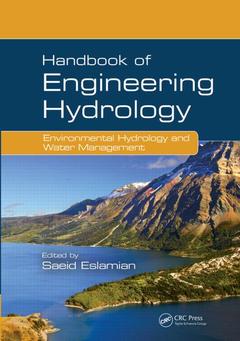Handbook of Engineering Hydrology Environmental Hydrology and Water Management
Coordonnateur : Eslamian Saeid

While most books examine only the classical aspects of hydrology, this three-volume set covers multiple aspects of hydrology, and includes contributions from experts from more than 30 countries. It examines new approaches, addresses growing concerns about hydrological and ecological connectivity, new quantitative and qualitative managing techniques and considers the worldwide impact of climate change.
It also provides updated material on hydrological science and engineering, discussing recent developments as well as classic approaches. Published in three books, Fundamentals and Applications; Modeling, Climate Change, and Variability; and Environmental Hydrology and Water Management, the entire set consists of 87 chapters, and contains 29 chapters in each book.
The chapters in this book contain information on:
? The anthropocenic aquifer, groundwater vulnerability, and hydraulic fracturing, and environmental problems
? Disinfection of water, environmental engineering for water and sanitation systems, environmental nanotechnology, modeling of wetland systems, nonpoint source and water quality modeling, water pollution control using low-cost natural wastes, and water supply and public health and safety
? Environmental flows, river managed system for flood defense, stormwater modeling and management, tourism and river hydrology, and transboundary river basin management
? The historical development of wastewater management, sediment pollution, and sustainable wastewater treatment
? Water governance, scarcity, and security
? The formation of ecological risk on plain reservoirs, modification in hydrological cycle, sustainable development in integrated water resources management, transboundary water resource management, and more
Students, practitioners, policy makers, consultants and researchers can benefit from the use of this text.
Anthropocenic Aquifer: New Thinking. Artificial Recharge Experiences in Semiarid Areas. Disinfection of Water and Nanotechnology. Environmental Engineering for Water and Sanitation Systems. Environmental Flows. Environmental Nanotechnology. Formation of Ecological Risk on Plain Reservoirs. Groundwater Vulnerability. Historical Development of Wastewater Management. Hydrofracturing and Environmental Problems. Modeling of Wetland Systems. Modifications in Hydrological Cycle. Nonpoint Source and Water Quality Modeling. River Managed System for Flood Defense. Sediment Pollution. Stormwater Modeling and Management. Stormwater Modeling and Sustainable Management in Highly Urbanized Areas. Integrated Water Resource Management and Sustainability. Sustainable Wastewater Treatment. Tourism and River Environment. Transboundary River Basin Management. Transboundary Water Resource Management. Updating the Hydrological Knowledge: A Case Study. Water Governance. Water Pollution Control Using Low-Cost Natural Wastes. Water Resources Assessment in a River Basin Using AVSWAT Model. Water Scarcity. Water Security: Concept, Measurement, and Operationalization. Water Supply and Public Health and Safety. Index.
Saeid Eslamian is an associate professor of hydrology at Isfahan University of Technology, Iran. He received his BS in water engineering from Isfahan University of Technology in 1986, his master’s degree in hydrology and water resources at Tarbiat Modares University, Tehran in 1989, and his PhD in civil engineering at the University of New South Wales, Sydney, Australia in 1995. He is the founder and chief editor of the International Journal of Hydrology Science and Technology and the Journal of Flood Engineering, and has contributed to more than 300 publications. He has received two ASCE and EWRI awards from the United States, and an outstanding researcher award from Iran.
Date de parution : 04-2014
Ouvrage de 646 p.
17.8x25.4 cm
Thèmes de Handbook of Engineering Hydrology :
Mots-clés :
Ns Ns Ns Ns Ns; Urmia Lake Basin; Anthropocenic Aquifer: New Thinking; Swat Model; Environmental Flows; NPS Contaminant; Environmental Nanotechnology; Transboundary Water Resource Management; Groundwater Vulnerability; IWRM; Sediment Pollution; MPA Degree; Surface Runo; Stormwater Runo; Eth Zurich; Isfahan University; Pr E20; Groundwater Vulnerability Assessments; San JUAN; Stormwater Modeling; Reservoir Sections; Unit Hydrograph; Limpopo River Basin; Urban Heat Islands; Seawater Intrusion; Transboundary Water; Lake Urmia; RHA Particle



